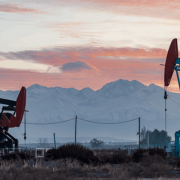⚠️ IMPORTANT LEGAL DISCLAIMER:
The information provided on this page is for general informational purposes only and does not constitute legal, financial, or investment advice. Oil and gas laws, mineral rights regulations, and royalty structures vary significantly by state and jurisdiction. While we strive to provide accurate and up-to-date information, no guarantee is made to that effect, and laws may have changed since publication.
You should consult with a licensed attorney specializing in oil and gas law in your jurisdiction, a qualified financial advisor, or other appropriate professionals before making any decisions based on this material. Neither the author nor the publisher assumes any liability for actions taken in reliance upon the information contained herein.
Investing in oil and gas can be an attractive option for individuals and companies seeking to diversify their portfolios, generate income, and participate in an industry that has long been a cornerstone of global economies. However, like any investment, oil and gas ventures come with risks and challenges, especially with the fluctuating nature of commodity prices and the complex regulations surrounding the industry. One of the primary ways to make these investments more appealing and financially viable is through various tax incentives that help offset some of the inherent risks and expenses.
For those considering oil and gas investments in 2025, understanding the available tax incentives is crucial. These incentives can not only reduce the upfront costs of investment but can also help enhance profitability in the long run. This guide will explore the various tax incentives available to investors in the oil and gas sector, how they work, and how to make the most of them to maximize your investment returns.
Overview of Tax Incentives for Oil and Gas Investments
A variety of tax credits, deductions, and other benefits incentivize oil and gas investments to encourage exploration, production, and infrastructure development within the energy sector. These incentives are part of broader efforts by governments to reduce energy dependence, promote energy security, and support the growth of domestic oil and gas production.
Tax incentives in the oil and gas sector come from both federal and state governments, and the structure of these incentives varies depending on the specific circumstances of the investment and the region where the resources are located. For investors, it’s critical to stay informed about available tax breaks, as they can make a substantial difference in the financial outcomes of an investment. Let’s explore the major tax incentives available to oil and gas investors for 2025.
Exploration and Development Deductions
Incentives for exploration and development activities form the cornerstone of tax benefits available to oil and gas investors. The U.S. tax code offers favorable deductions for companies and individuals engaged in the exploration and development of oil and gas properties. These deductions are designed to encourage investment in activities that often require significant capital expenditures and come with high upfront costs.
The Intangible Drilling Costs (IDCs) are one of the most valuable tax incentives for oil and gas investments. IDCs refer to the costs associated with drilling wells, such as labor, fuel, supplies, and other expenses related to drilling operations. In many cases, these costs are fully deductible in the year they are incurred, which allows investors to recover a significant portion of their expenses much sooner than through other types of deductions.
In addition to IDCs, investors can also take advantage of Tangible Drilling Costs (TDCs), which refer to physical assets like rigs and equipment. These costs may be depreciated over a period of time, typically five to seven years, allowing for substantial tax relief over the life of the investment.
For those involved in oil and gas drilling and development, these deductions can significantly reduce taxable income, enabling investors to save money in the early stages of a project.
Percentage Depletion Allowance
Another key tax incentive for oil and gas investments is the Percentage Depletion Allowance, which allows investors to deduct a percentage of the gross income derived from the production of oil and gas. This tax break is particularly beneficial for mineral rights owners, royalty holders, and small independent producers who may not have the high capital expenses associated with large-scale drilling operations.
Under the Percentage Depletion Allowance, producers can deduct a portion of their revenue (usually up to 15%) from the gross income generated by the sale of oil and gas. This is in addition to other tax benefits like IDCs, making it a powerful tool for reducing taxable income over the life of an investment. The percentage depletion benefit applies even if the investor has already recovered the original cost of the mineral rights, providing an ongoing source of tax relief as long as the production continues.
It is important to note, however, that the Percentage Depletion Allowance is capped for larger producers. There are limits on the amount of depletion that can be claimed by individuals or entities with gross income exceeding certain thresholds. As a result, the benefit tends to be more advantageous for smaller producers or those involved in royalty-based investments.
Credits for Enhanced Oil Recovery
Enhancing oil recovery from existing wells is an important strategy for increasing production without the need to drill new wells. For investors involved in enhanced oil recovery (EOR) projects, there are tax incentives designed to encourage the use of advanced technologies to extend the life of oil reservoirs and increase recovery rates.
One of the most prominent credits available is the Enhanced Oil Recovery Tax Credit, which provides a financial incentive for producers who use advanced recovery methods like waterflooding, CO2 injection, and other technologies to boost the production of oil and gas from existing wells.
This credit can significantly reduce the overall costs of implementing enhanced recovery techniques, which are often capital-intensive and require advanced technological investments. The credit is typically available to producers who use EOR techniques on wells that were initially drilled after a specific date, often tied to a set period defined by the tax code.
In addition to the federal EOR credit, there may be state-level credits or grants available for EOR projects in certain regions, so it’s important for investors to explore opportunities in their state of operation.
Tax Incentives for Small Independent Producers
Small independent producers in the oil and gas industry often face unique challenges when it comes to accessing capital and generating profits. To help offset these challenges, the tax code provides a variety of incentives specifically designed for smaller producers.
One such incentive is the Small Producer Tax Credit, which applies to individuals and companies with relatively modest levels of production. This credit helps smaller oil and gas producers reduce their federal tax liability, enabling them to reinvest in further exploration, development, and production activities.
Small producers may also benefit from exemptions on certain environmental compliance requirements or additional tax deductions related to operational costs, equipment, and land development. As with other tax incentives, these benefits are subject to various eligibility criteria, and it’s important for small producers to understand how they can take advantage of these credits to maximize their investment returns.
Tax Benefits for Investing in Oil and Gas Partnerships
Another attractive avenue for oil and gas investments is through partnerships, which can provide tax benefits to both individual investors and larger corporations. Investors commonly use Master Limited Partnerships (MLPs) and Limited Liability Companies (LLCs) in the oil and gas industry to facilitate investment while minimizing tax exposure.
In an MLP, investors typically receive income generated by oil and gas assets in the form of quarterly distributions.
Tax authorities generally tax these distributions at a lower rate than ordinary income, making MLPs a tax-efficient option for generating passive income from oil and gas investments. MLPs also provide investors with the benefit of pass-through taxation, meaning that federal taxes do not apply to the partnership itself—rather, individual investors report the income on their personal tax returns.
Investors can structure LLCs similarly but with more flexibility in how they are taxed. They can treat LLCs as pass-through entities for tax purposes, enabling them to avoid double taxation on income generated from oil and gas operations.
LLCs also offer protection from liability, which is important for those investing in the inherently risky oil and gas industry.
Tax Incentives for Carbon Capture and Storage
In recent years, carbon capture and storage (CCS) technologies have gained significant attention as part of efforts to reduce the environmental impact of oil and gas production. CCS captures carbon dioxide emissions from industrial processes and stores them underground to prevent their release into the atmosphere.
To encourage the development and deployment of CCS technologies, the U.S. government offers tax credits for carbon capture. These credits, known as the 45Q Credit, provide financial incentives for companies that invest in CCS projects. Investors interested in sustainable and environmentally responsible oil and gas practices can claim the tax credit for each ton of carbon dioxide captured and stored, making it a valuable incentive.
For investors in oil and gas projects that incorporate CCS, this credit can provide substantial tax relief while contributing to reducing the carbon footprint of the energy industry.
State-Level Tax Incentives
While federal tax incentives play a significant role in oil and gas investments, many states also offer their own set of tax benefits designed to attract investment and stimulate local oil and gas production. State-level incentives vary widely and can include property tax reductions, severance tax exemptions, and state-specific tax credits or deductions for exploration and drilling activities.
For example, some states like Texas and Oklahoma offer incentives for drilling new wells or revitalizing old wells, while states like Wyoming may offer severance tax exemptions for certain types of production activities. These state-level incentives can significantly reduce the overall tax burden on oil and gas investments, improving cash flow and profitability for investors.
Investors should consult with local tax professionals to determine which state-specific incentives are available in the region where they are operating.
In Conclusion
Oil and gas investments offer significant potential for returns, but navigating the complex tax landscape can be challenging. Fortunately, a variety of tax incentives are available to help investors offset the costs of exploration, development, production, and environmental initiatives. From deductions for drilling costs to credits for enhanced recovery and carbon capture, these incentives play a vital role in making oil and gas investments more attractive and financially feasible.
For those looking to invest in the oil and gas industry in 2025, understanding the available tax incentives is critical for maximizing returns and ensuring efficient investment structuring. By leveraging these incentives, investors can mitigate risks, reduce costs, and take full advantage of the opportunities presented by this essential sector. As with any investment, consulting with financial advisors, tax professionals, and legal experts who specialize in oil and gas is crucial to navigating the complexities of the industry and optimizing investment strategies.
Do you have any questions related to Tax incentives for oil? Contact Us here.
Remember: This information is for educational purposes only. Consult qualified professionals for advice specific to your situation and jurisdiction.










